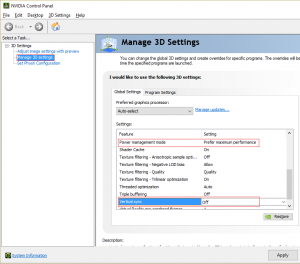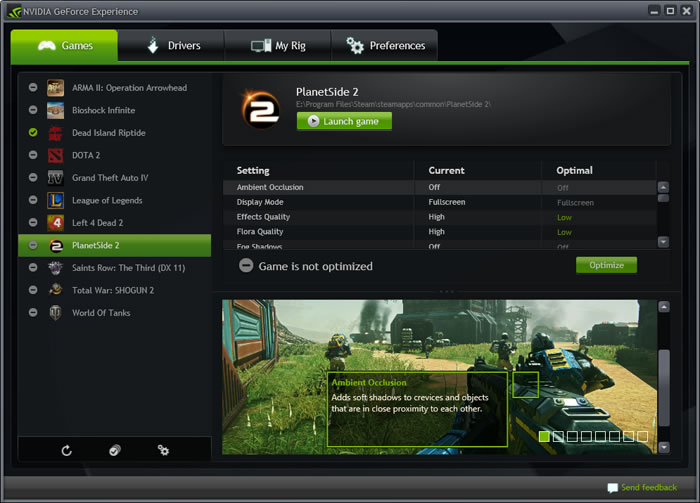

- #Nvidia geforce power management install#
- #Nvidia geforce power management drivers#
- #Nvidia geforce power management driver#
- #Nvidia geforce power management 32 bit#
Note: No configuration is generally needed for Ampere as this is enabled by default. $ cat /sys/class/drm/card*/device/power_state The following command can be used to check current power state of each GPU: This feature is supported by modesetting, xf86-video-amdgpu, xf86-video-intel, xf86-video-nouveau drivers. Kernel PCI power management turns off the GPU when not used with PRIME offloading or reverse PRIME.
#Nvidia geforce power management drivers#
PCI-Express Runtime D3 (RTD3) Power Management Open-source drivers $ prime-run glxinfo | grep "OpenGL renderer" To run a program on the NVIDIA card you can use the prime-run script provided by nvidia-prime: The modesetting, xf86-video-amdgpu (450.57), and xf86-video-intel (455.38) are officially supported as iGPU drivers.
#Nvidia geforce power management driver#
NVIDIA driver since version 435.17 supports this method.
#Nvidia geforce power management 32 bit#
See Gentoo:AMDGPU#Test, if a discrete graphics card is in use for more information.įor DRI_PRIME to work on Vulkan applications vulkan-mesa-layers needs to be installed, as well as lib32-vulkan-mesa-layers for 32 bit applications. This may reduce your battery life and increase heat though. These settings are lost once the X server restarts, you may want to make a script and auto-run it at the startup of your desktop environment (alternatively, put it in /etc/X11/xinit/xinitrc.d/). Other applications will still use the less power-hungry integrated card. Format used is similar to /sys/bus/pci/devices/, but prefix with pci- and replace semicolons and dots by underscores, e.g. Note: Instead of numerical value, you can also specify a PCI device name. The provider and sink identifiers can be numeric (0x7d, 0x56) or a case-sensitive name (Intel, radeon). The command xrandr -setprovideroffloadsink provider sink can be used to make a render offload provider send its output to the sink provider (the provider which has a display connected). We want to render applications on the more powerful card and send the result to the card which has display connected. You do not need to uninstall the open-source drivers for it to function, but you probably should, for the sake of preventing clutter and potential future issues. Depending on your system configuration, this may render your Xorg system unusable until reconfigured.įollow the instructions for the section on your designated use-case.

#Nvidia geforce power management install#
NVIDIA to install drivers for NVIDIA GPUs.Īfter you have the driver installed, do not reboot or relaunch Xorg.AMDGPU PRO to install drivers for AMD GPUs.Follow the following articles to install the drivers: To get PRIME functioning on the proprietary drivers, it is pretty much the same process. In this case you should use "HAINAN pci:0000:03:00.0" as the provider in the next command. Note: Sometimes, the displayed provider is "HAINAN pci:0000:03:00.0", not radeon. $ glxinfo | grep "OpenGL renderer" OpenGL renderer string: Mesa DRI Intel(R) Ivybridge Mobile We can see that there are two graphic cards: Intel, the integrated card (id 0x7d), and Radeon, the discrete card (id 0x56), which should be used for GPU-intensive applications.īy default the Intel card is always used: Provider 1: id: 0x56 cap: 0xf, Source Output, Sink Output, Source Offload, Sink Offload crtcs: 6 outputs: 1 associated providers: 1 name:radeon Provider 0: id: 0x7d cap: 0xb, Source Output, Sink Output, Sink Offload crtcs: 3 outputs: 4 associated providers: 1 name:Intel $ xrandr -listproviders Providers: number : 2

Reboot and check the list of attached graphic drivers: Remove any closed-source graphic drivers and replace them with the open source equivalent: PRIME GPU offloading and Reverse PRIME are an attempt to support muxless hybrid graphics in the Linux kernel. PRIME is a technology used to manage hybrid graphics found on recent desktops and laptops ( Optimus for NVIDIA, AMD Dynamic Switchable Graphics for Radeon).


 0 kommentar(er)
0 kommentar(er)
